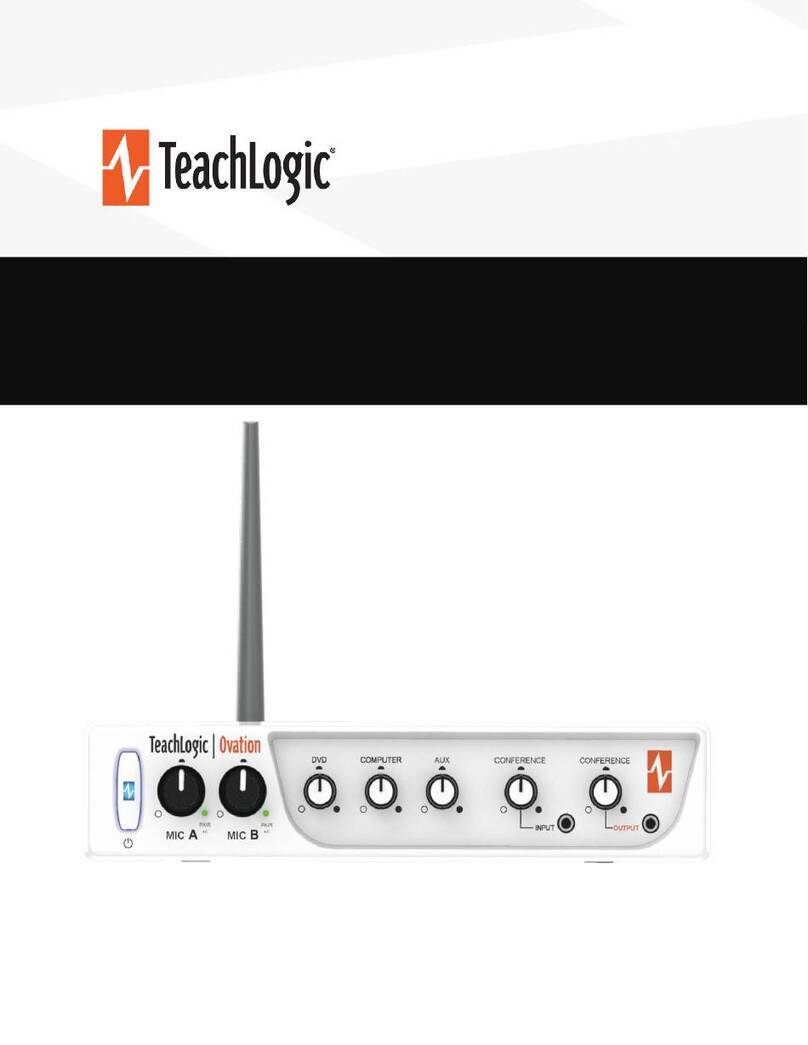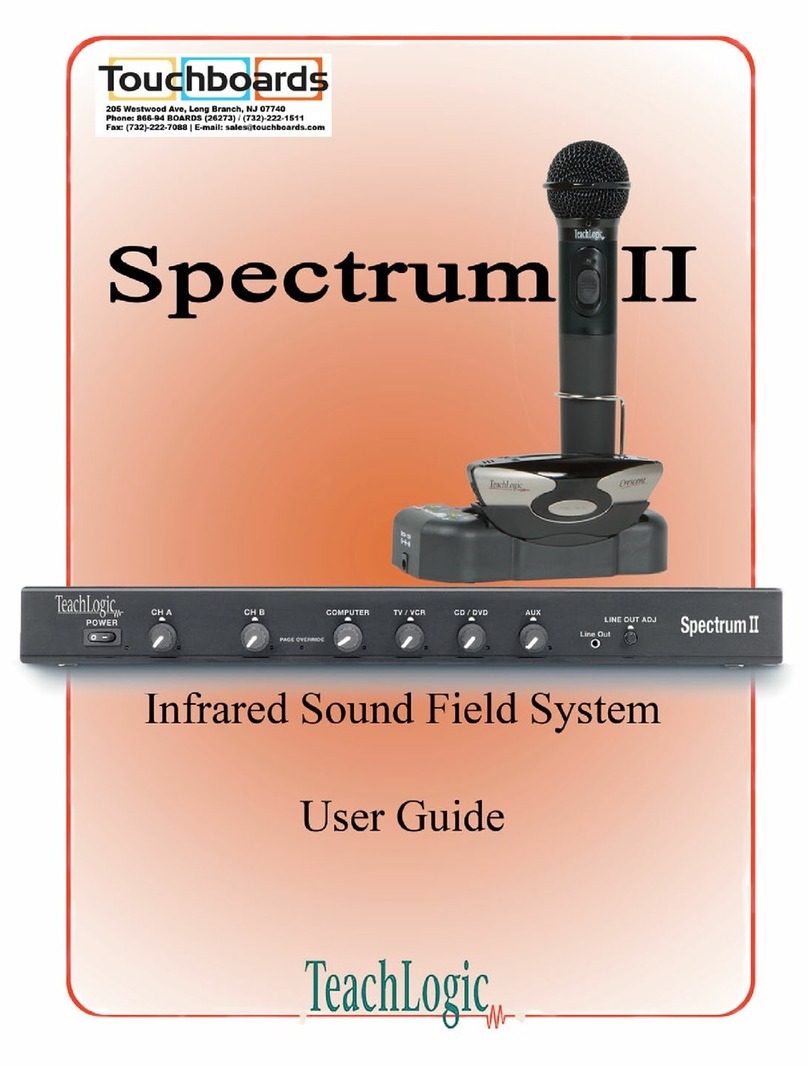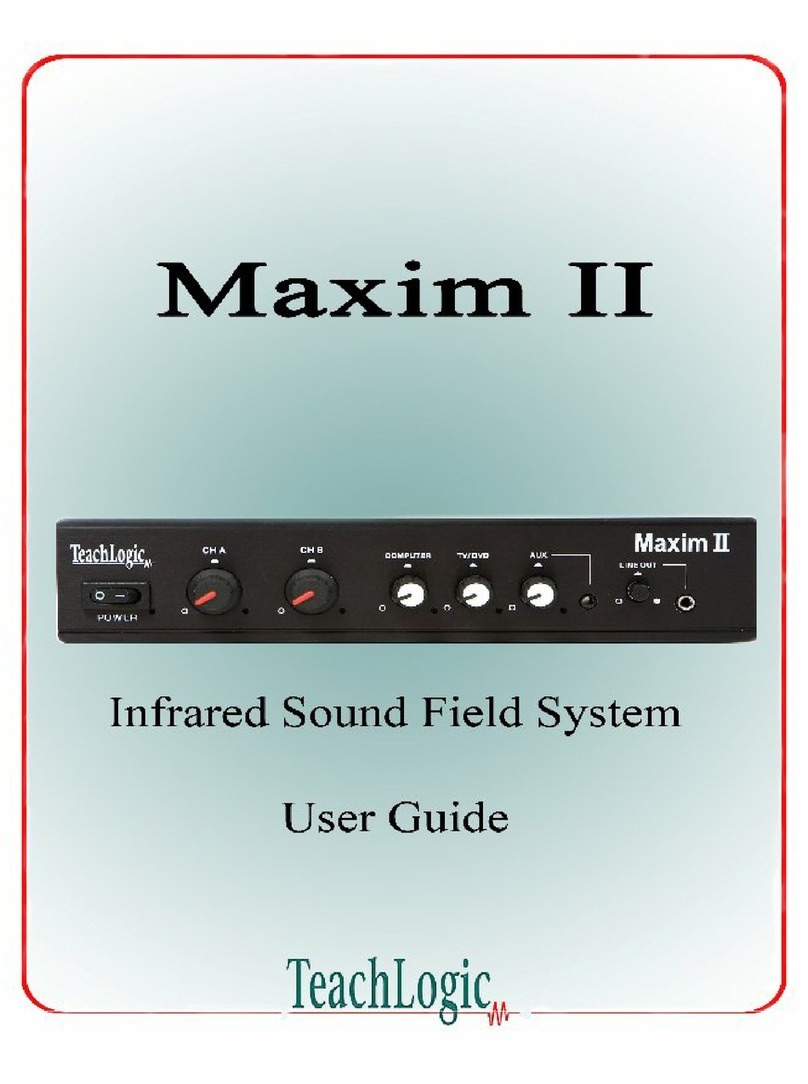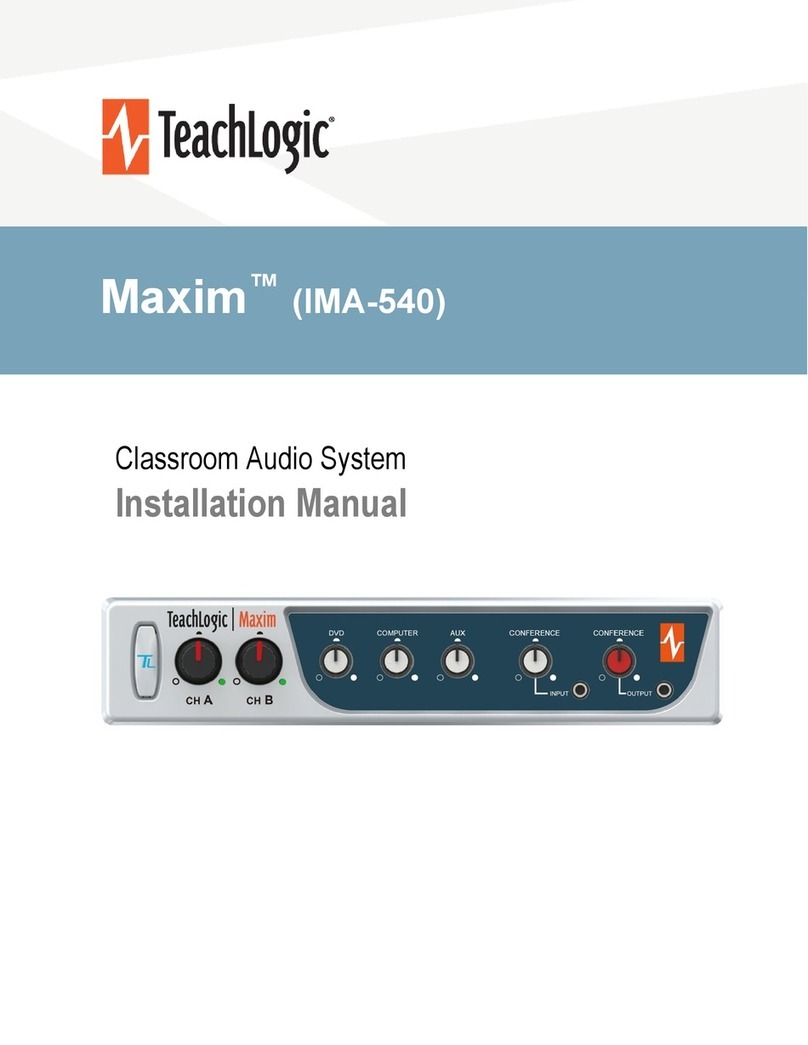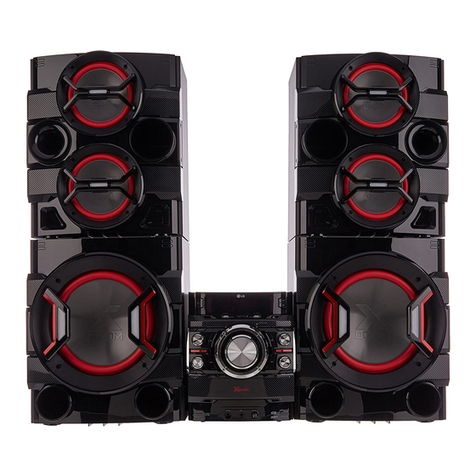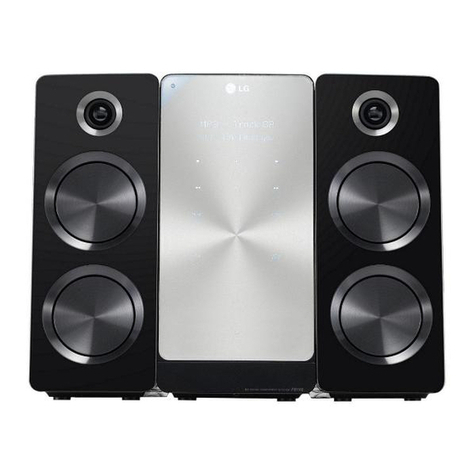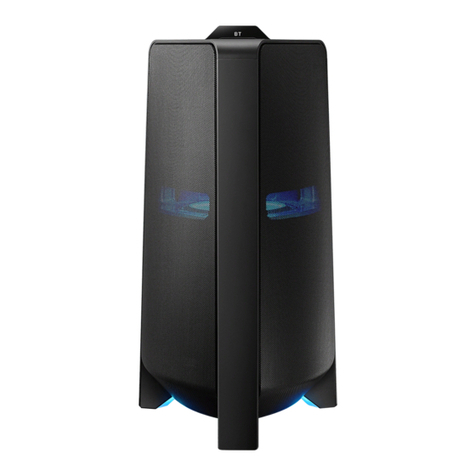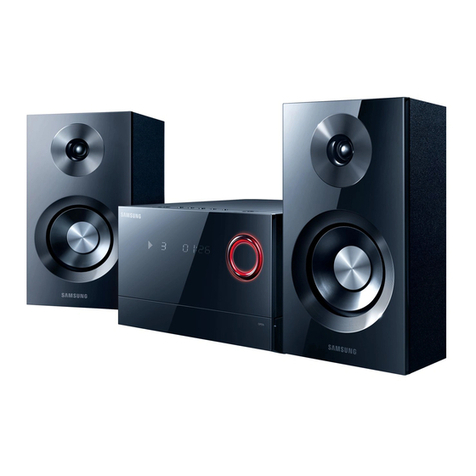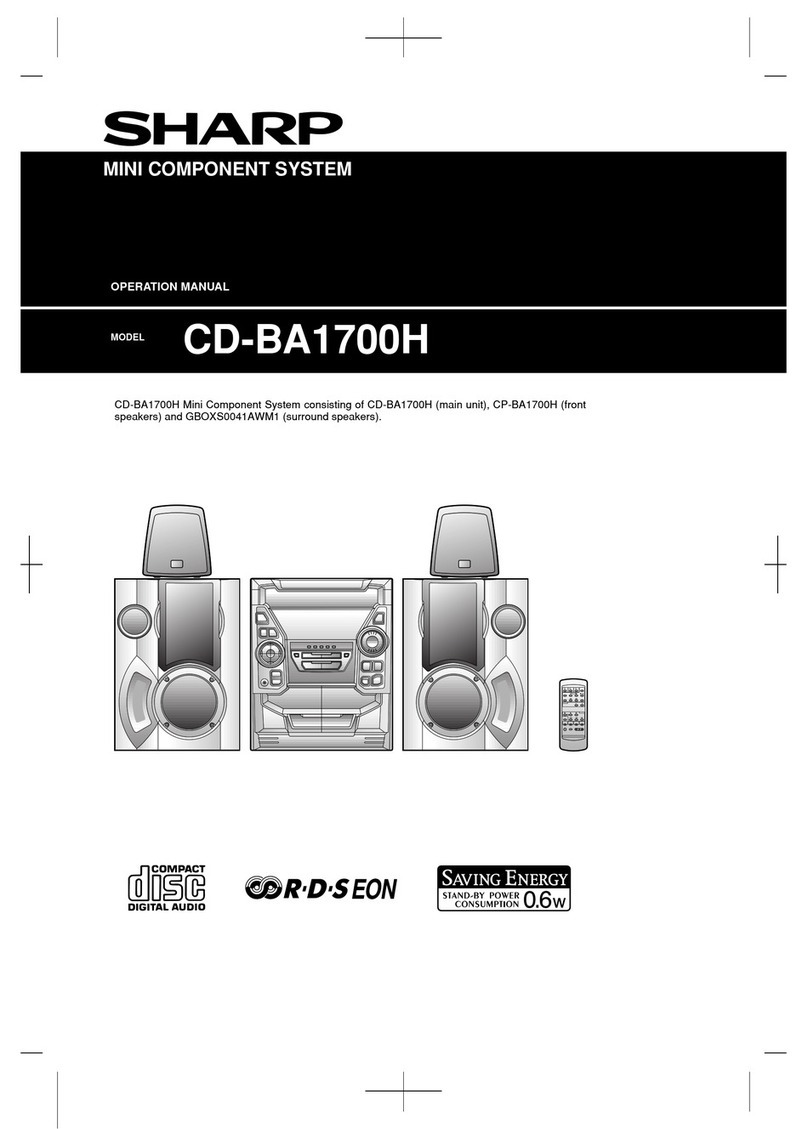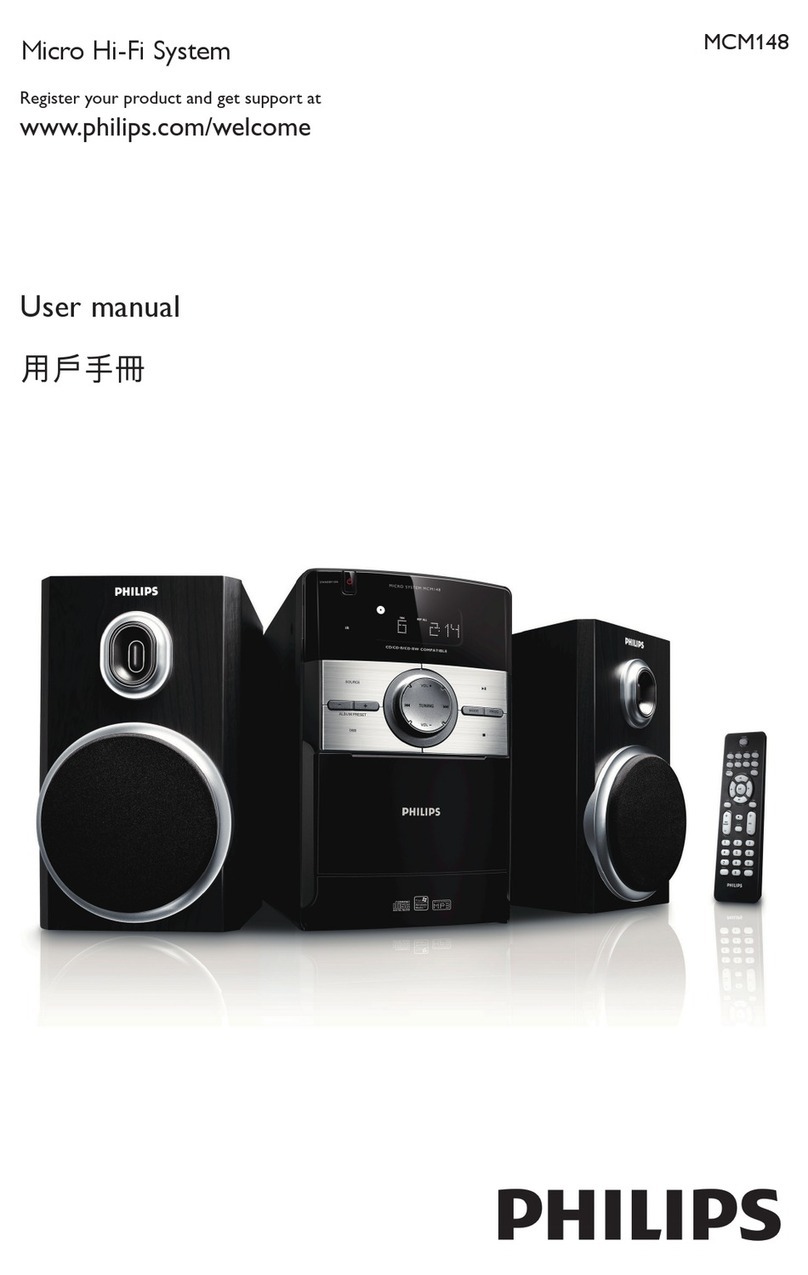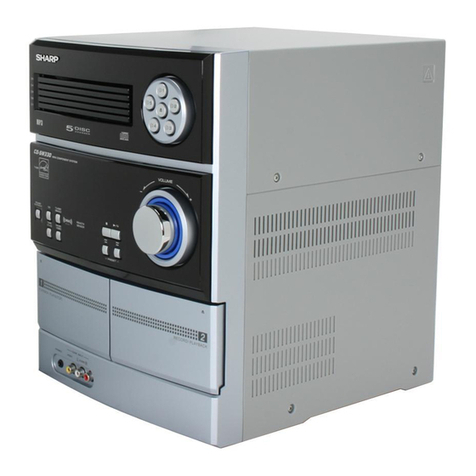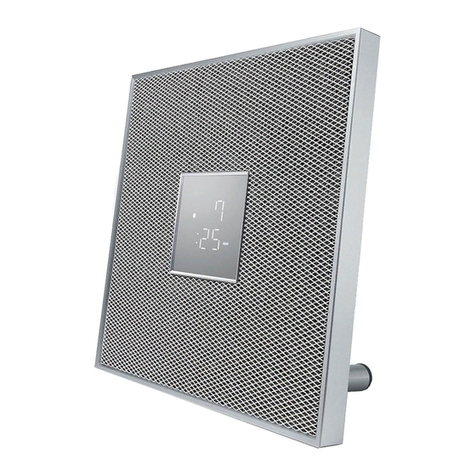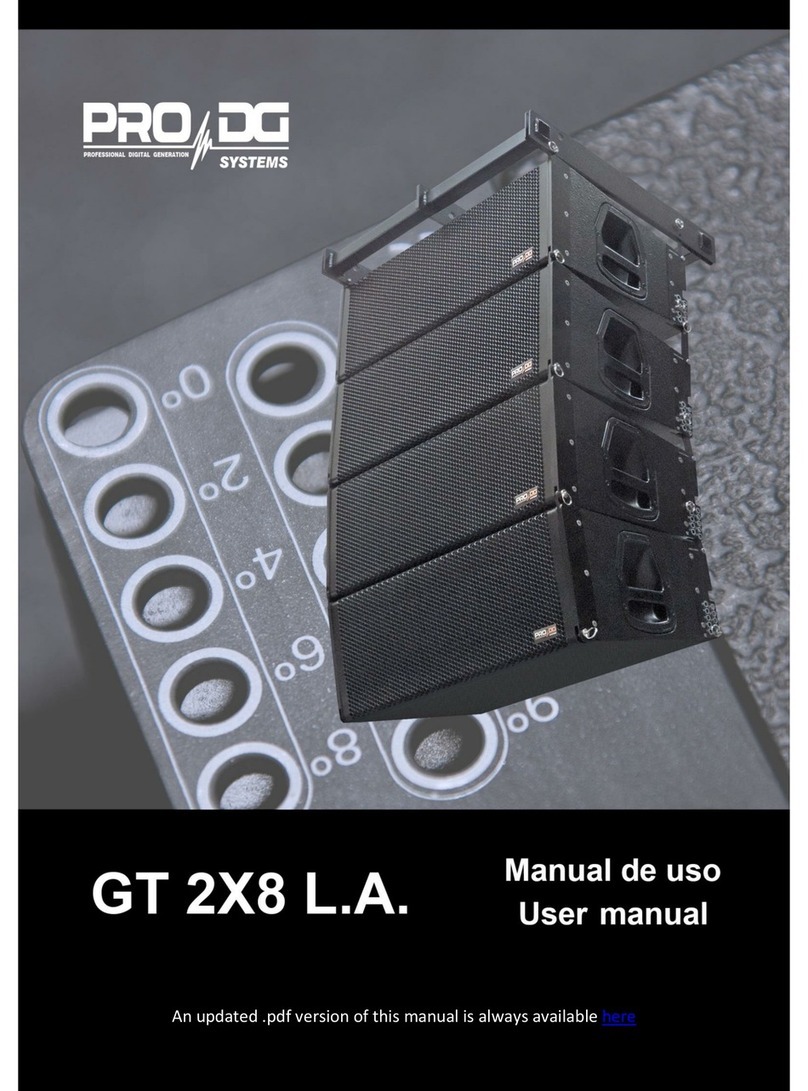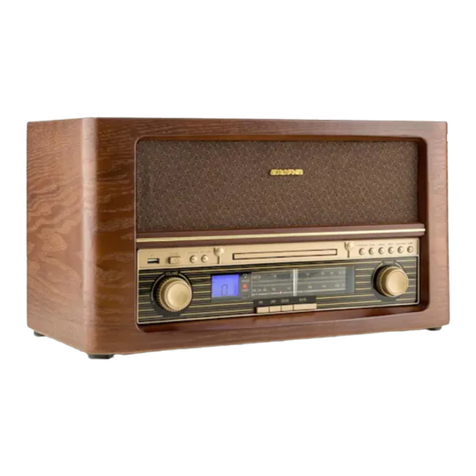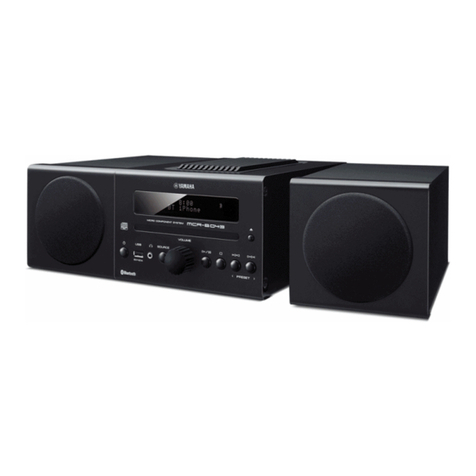TeachLogic Maxim II User manual


FORWARD
Congratulations on the purchase of your new Maxim II Sound
Field System produced by TeachLogic. Be assured that the
Maxim II meets all specifications and was produced to very
high quality control standards. TeachLogic incorporates the
latest state of the art technology, employs the most advanced
manufacturing methodology and uses only premium quality
components to assure many years of reliable performance. We
appreciate your confidence by selecting a TeachLogic product
and it is TeachLogic’s intent to support you in the use of your
system.
We hope you will take some time to review this manual to
familiarize yourself with the product features and its
performance. The manual will help guide you to gain
maximum use and benefit of the Maxim II sound field system.
The manual provides some basic explanation on the basic
principles of Infrared transmission and its benefits. To be
followed up with operator instruction and installation
instruction. The manual will conclude with maintenance
procedures and trouble shooting analysis.
If you should encounter some unresolved issue, please contact
TeachLogic customer service department for further
assistance.
Telephone Number: 800-588-0018
e-mail: teachlogic.com
Brian Van Waay , President

How the System Works
A Brief Word About Infrared
Infrared is a light ray that is below the visible light spectrum,
just like the sound spectrum extends beyond your hearing
ability. An example of infrared transmission: is the remote
control for your TV set. A beam of infrared light is emitted by a
Light Emitting Diode (LED) from the remote control and it is
detected by a receiving diode in your TV set. When you push a
certain command on your control, the internal electronics
causes the infrared light to flicker in a programmed sequential
pattern (called modulating the light beam). The modulated
infrared beam is detected by a receiving diode and is
electronically decoded. The decoded signal activates the
circuitry to perform the command function on the TV set.
So how does this apply to the infrared communication system
you are about to start using? The body-pack transmitter or
handheld microphone has several Light Emitting Diodes (LED)
that emit infrared light beams to the sensor located on the
ceiling (the dark red doom). Now when you talk into the
microphone, the microphone element modulates the light
beam, causing it to flicker in sync with your speech. The dome
sensor detects that sequential signal and an electronic signal
is sent to the receiver inside the Maxim II mixer/amplifier unit.
The receiver decodes the signal from the sensor and converts it
into an electronic audio signal that is sent to the amplifier.
The amplifier magnifies the electronic signal which is sent to
the speakers. This causes speaker cone to move back and
forth in sync with your voice. The speaker replicates your voice
and disperses it so all can hear with ease.
The IR signal will bounce off the walls, ceiling, floor, and be
received by the sensor; therefore, the transmitter does not
have to be pointed at the sensor. Thus providing total freedom
of movement within the room. However, infrared will not
penetrate solid surface thus preventing transmission from
going out of the room.
“What’s said in the room, stays in the room”.

Features and Description of the Maxim System
Mixer/amplifier (IMA-420) is the nucleus of the
classroom sound field system. The pendant transmitter, body-
pack transmitter or handheld microphone transmitter:
transmit the vocal signal via infrared light to the dome sensor
installed on the ceiling. The signal is then sent via cable to the
receiver input of the mixer/amplifier. The signal is detected
and then processed through the power amplifier to the
speakers.
Front Panel _______________________________________________
Power Switch with an associate red LED to indicate presence
of power.
Channel “A” & “B” wireless microphone volume controls.
IR Indictor, LED adjacent to each control knob will light
“Green” when a transmitter on that channel is turned “on”,
validating an IR transmission signal is being received.
Input Controls for adjusting the volume of each media input
source; COMPUTER, TV/DVD, AUX. An associate LED will
light “Green” when an audio signal is present on that input.
Front Panel Auxiliary Input for “ipod” or similar device
(3.5mm). The rear auxiliary input will disengage when the
front input is in use and the “AUX” control will adjust the
volume.
Line Out is for an “Assistive Listening System”, Personal FM
system or could used as a record output. Gain control adjusts
the output signal to match the input of the auxiliary devise.

Rear Panel _________________________________________________
Power Input is 15 volts DC, 2.8 A.
Two Amplifier Outputs each terminated by a dual latching
Phoenix connector (facilitating connecting two speakers in
parallel).
Power output of each amplifier:
16 watt (RMS) into 4Ωload or
12 watt (RMS) into 8Ωload
Five-band Graphic Equalizer provides the installer capability
to compensate for acoustical variance and maximum vocal
clarity. A protective cover prevents maladjustment once the
system has been professionally calibrated for optimum
performance.
Page Over-ride allows the school announcements to pass
through the classroom sound system. The announcing system
(speaker level 25, 70, or 100 volt, selectable) is connected via
the two-pin phoenix connector and the volume is adjusted
with the gain control. The page will mute all the inputs during
the page and restore to previous levels after page is completed.
Auxiliary Audio Inputs (stereo RCA) for various media
sources such as: Computer, DVD, Projector, VCR, or other.
The normal sensitivity of these inputs is -25 dB but the
sensitivity of each can be increased with the sensitivity gain
control adjacent to the input (up to 15dB).
Sensor Inputs (RCA) for powering the sensor and receiving IR
transmission signal. Two sensor inputs allow installation of an
additional sensor for odd shaped or large rooms requiring
additional coverage. Normally only one sensor is required.

Infrared Dome Sensor (ICS-55)The ceiling sensor is the
preferred infrared sensor for optimum performance. It comes
standard with Maxim II, Spectrum II, VoiceLink II and
VoiceLink IV packages. This is the unit that needs to be
installed on the ceiling. It comes with a mounting/support
bracket and 50 feet of plenum rated cable with RCA connector
on each end. The ideal location for the dome sensor would be
in the center of the ceiling. This will provide a clear signal path
for the IR transmission from the transmitter to the dome
sensor without obstruction. In addition, you will have 360°
coverage and will minimize the transmission distance for more
reliable performance. It
collects the infrared
transmission signal via 6
large detecting diodes. The
sensor is connected to the
mixer/amplifier via a plenum
rated cable terminated with
RCA connectors. The
mixer/amplifier supplies the
power to the sensor.
Drop-in Battery Chargers
The battery chargers were specifically designed to recharge
NiMH batteries at an optimum rate
to maximize their use. The
chargers feature a recycle function,
which is used to restore the battery
charge capacity and extend their
service life.
BRC-50 charger recharges the
Crescent (IRT-30) and Body-Pack
transmitter (IRB-30). You merely
place the Crescent or body-pack in
their respective slot. Connection
will be made and charging will
commence. Charger will
automatically control the rate and
maintain the charge.

BRC-101 and BRC-202 drop-in chargers are for the handheld
(IRH-30) and pendant transmitter (IRT-89). The single slot
(BRC-101) can charge either or the dual (BRC-202) can charge
both simultaneously. In addition, both have a tray to insert
two “AA” batteries for recharging.
Crescent (IRT-30)
The Crescent is a lightweight
microphone/transmitter designed
to be worn under the chin
suspended by an adjustable
lanyard. The Crescent shape was
designed for efficient performance
and user comfort. The dual
internal microphones render
optimum voice pick up and quality reproduction. The Crescent
provides an auxiliary input (3.5mm) to accommodate the
insertion of an iPod™ or similar device for supplementary
program material.
A soft touch mute button cuts the microphone “off” for private
conversation (the power LED will flash in the mute position). A
volume control allows adjustment of the microphone volume.
The external battery contacts accommodate the convenient
use of a drop-in charger.

Pendant Transmitter (IRT-89) with built-in
microphone. The pendant transmitter is the
smallest transmitter and is usually worn around
the neck. Two lanyards are provided: one with a
safety breakaway clasp and a longer adjustable
over the head style. The transmitting diodes are in
the top portion and the rechargeable NiMH
batteries are housed below. The power switch is
accompanied by a battery level LED
(Green=Useable, Red=Needs Charge). The A-B
switch selects the transmission channel. The
pendant can be placed in either the BRC-101 or BRC-202
charger.
An optional Plug-in microphone (LM-300) can be plugged into the
top of the pendant for enhanced performance. Although the
built-in microphone gives satisfactory performance, the plug-in
microphone is a unidirectional element resulting in better vocal
quality and much more gain (more volume) before feedback.
Body-Pack Transmitter (IRB-30),
usually worn on the waistband, is the
component that transmits the IR signal
to the sensor. The IRB-30 has 10
emitting diodes on its front panel and is
powered by two rechargeable NiMH
batteries. Controls include a power
“on/off” switch and a mic gain control.
Battery level indicator LED: Green =
useable charge, Red = low battery.
It is required to plug in an external
microphone. There are several optional
microphones available and they plug
into the top of the IRB-30. The IRB-30 is
equipped with belt clip for waist
attachment.
d the red
window canno are the emitting diodes.
Caution: The body-pack cannot be placed in pocket an
t be obstructed, those

Plug-in Microphone (LM-300) is a small capsule
size microphone that plugs directly into the top of
the IRB-30 body-pack. A lanyard cord is provided
to accommodate wearing the body-pack transmitter
around the neck and utilizing it as a pendant
microphone supported b
boom extends along si
microphone with winds
comfort,
M
h
ollar mic utilizes a
mic element to
elapel
e
o rther away
ired
omni-
ent is
ctions.
lapel
microphone most prone to feedback
when used near or under a speaker.
microphone. A windscreen is included to prevent
breath pops when used in close proximity to the
mouth.
Ultra Lite Microphone (ULM-835) is a miniature boom style
y a wire around the left ear. The mic
de of face and has a unidirectional
creen. The small ring on the boom
prevents perspiration from entering
the mic element. Aside from
the boom style mic renders the best
performance in terms of sound quality
and is not prone to feedback.
Caution: The boom can be formed to fit
but it is not a flexible boom, do not
bend back and forth. IT WILL BREAK !
-838) is a flexible rod that is formed
e end with the microphone and
windscreen is then contoured up
toward the mouth. The cord exits the
rod in the center in back, out of the
way, and is plugged into the body-
pack. The c
Collar Microphone (C
around the neck. T
unidirectional
minimize feedback and renders
quality voice reproduction.
Lapel Microphone (LP-835) is a small capsule microphone
curing on to a clothing edge. The
d for out of sight application.
f the microphone being fa
from the mouth, more gain is requ
for adequate volume. An
directional microphone elem
used to pick up from all dire
These two factors make the
with a spring clip for s
microphone is well suit
However; as a result

Handheld Microphone Transmitter (IRH-30) is
most applicable for student use or direct
presentation. It has an “on/off” switch and a battery
level indicator LED; Green=useable charge, Red=low
battery. The transmitter has 10 emitting diodes
around the bottom of the handle. The metal housing
rovides low handling noise and insures durable
Spea
for
upport above the ceiling tile. Plenum rated cable is
rovided for connecting the speakers to the amplifier.
pecification: SP-628 speaker is ETL plenum
rated and meets the UL-2043 plenum code.
Heavy-duty speaker
ire is provided for connecting the
peakers to the amplifier.
p
longevity.
kers:
Ceiling Speaker (SP-628) is an extended frequency
range 6” co-axial speaker housed in a metal back can
sealed to the trim ring to form an infinite baffle
enclosure. A screw terminal strip provides the external
speaker connection. The speakers are equipped with
three quick mount clamps for easy mounting into a blind
hole. The speakers are supplied with a tile bridge
s
p
S
Wallmount Speaker (SP-2000) is
a two-way speaker housed in a
port tuned enclosure with a 6”
woofer and a 1” H.F. domed
tweeter. Euro-block connectors
provide the speaker connection.
Brackets are included for wall
mounting.
w
s

PRIOR TO INSTALLATION
all safety guidelines when using ladders
r heat
turdy shoes
es only
•
/Supplies required for Installation
ills
pe Measure
& Screws (If exposed wiring is required)
Electrical Tape
•Twine or Light Weight Pull Rope
Be sure to observe all safety precautions
•Wear goggles when using power tools.
•Observe
•Do not install your system near water o
sources
•Wear proper work clothing and s
•Clean all components with a dry cloth
•Use Teachlogic accessori
Protect all cables from abrasion, sharp edges, and
install in a tidy manner
The following Tools
•Safety Goggles
•Power Drill Motor & Dr
•Phillip #2 Screw Driver
•Level & Ta
•Side Cutter & Scissor
•Hammer
•Staple Gun & Staples
•Plastic Cable (zip) Ties
•Raceway
•Aviation Metal Cutters
•Ladder
•Keyhole or Drywall Saw
•

INSTALLATION INSTRUCTION FOR THE MAXIM II SYSTEM
Or
ganize and Plan Your Installation
Upon arrival to the jobsite, observe the following criteria:
•Observe the type of ceiling to determine your method
ocation of each speaker
location.
eiver/Amplifier) be
tion of the ceiling for
installation of the dome sensor and routing of the
sensor cable to the Max m II
of installation of the speakers
•Roughly layout the l
•For installation of wallmount speakers, determine the
mounting
•Where will the Maxim II (Rec
installed
•How will the Maxim II be mounted
•What will be the best routing of the speaker wires
•Where are the Auxiliary Audio Sources located and
how will they be Interfaced with the sound system
•Determine the central loca
i

ProcedureInstallation
In
utlet and the routing of the
pe
fre
e sides of the amplifier
screws provided.
h mounting hardware being used.
the support.
e
rack
•Mount the tabs on the side of the amplifier
•Install the Maxim II in the rack at desired location
stallation of the Maxim II
Placement of the Maxim II mixer/amplifier is usually
dictated by: what other equipment will be integrated with
the sound system, and how it will be mounted. Location of
the electrical AC power o
s aker and sensor cables. Cushion pads are installed for
e stance installation.
Installing the Maxim II under or above a shelf
•Use the SM – 700 shelf mount kit
•Mount the two tabs on th
using the threaded mounting holes and the
threaded
•The tabs can be mounted oriented inward or
outward
•With the tabs mounted, hold the amplifier in
position and mark the mounting holes
•Drill mounting holes in support structure in
accordance wit
•With tabs oriented outward, install the Maxim II
onto support
•With tabs oriented inward, remove the tabs and
install them on
•Insert and install the amplifier between th
mounted tabs
Installing the Maxim II in an electronic equipment
•Use the RM – 400 rack mount kit.

Installation of Speakers
The Maxim II can accommodate four (8Ώ) speakers. You will
connect two speakers in parallel and connect to one
amplifier. Do the same for the other two speakers. This will
distribute 8 watt to each sp
eaker. Four speakers will be
ou
d in the
Fo
he listening area and divide the area into four
enter of each
Fo
areas. Relay out the
ront to back) and equidistant side to side of
in the center of each
Installin 8 ceiling speaker
the
tile face down on clean flat surface
adequate to distribute sound evenly throughout a classroom
of approximately 2500 sq. ft.
When installing ceiling speakers in a dropped ceiling, y
need to consider will the room always be arrange
same seating arrangement or be moved about randomly?
r a room with permanent seating arrangement:
Designate t
quadrants. Then install one speaker in the c
quadrant.
r a room with random seating arrangement:
The whole room becomes the listening area. Begin by
splitting the room into four quadrants and skew away
from areas known not to be listening
area and divide into four quadrants and install one
speaker in center of each quadrant.
Smaller rooms may only require two speakers. Two speaker
installation, locate the speakers in the center of the
listening area (f
the listening area. Install one speaker
half quadrant.
g the SP – 62
•Locate and identify the speaker locations in the
ceiling grid
•With clean hands, remove the ceiling tile from
ceiling grid
•Lay ceiling
•Center the large hole of the tile bridge on the
ceiling tile
•Trace and cut the speaker hole using a keyhole or
drywall saw

•With the ceiling tile removed, measure the distance
able from speaker location
•
nnect Red wire to
a paper clip
er hole
ree quick clamps
ints
wire.
he two speaker cables together (Red to Red)
and Black to Black.
•Connect the Red pair to the (+) terminal and Black
to (C).
to the next speaker and cut a speaker cable
appropriate length.
•Strip the speaker cable ends approximately ¾”
•String the cut speaker c
to next speaker location.
•Reinstall the ceiling tile with the tile bridge located
above the speaker hole.
•With a pointed tool, remove the speaker grille.
Pull the speaker cable back through the speaker
hole and connect speaker cable to speaker
oCaution: Observe polarity, co
(+) terminal and other wire to the “C” terminal
•Remove the speaker grille using
•Insert speaker into speak
•Hold in place and tighten the th
with a #2 phillips screw driver.
•Reinstall speaker grille.
•Remove any soil and fingerpr
•Repeat above steps with the following additions:
•Measure distance from speaker to amplifier
•Cut and strip speaker
•Advance the wire from speaker to amplifier
•Twist t

Installing the SP-2000 Wall Mount Speakers
•First observe the shape of the room, ceiling height,
door locations, windows, mounting surfaces and
seating area. In a rectangular or square room, you
would locate the two wall speakers (one on each
loor. Using the most appropriate
•
Black (-)
•Route the speaker cable to the Maxim II; observing
safe, unsightly, least visible, and tidy route
•Remove any soil, fingerprints and debris.
side) approximately even with the front row
listeners. Locate the other pair approximately mid-
way to the rear of the listening area.
•The speakers should be mounted vertically about 5-
6 feet above the f
fastener, mount the speaker brackets onto the wall.
•Insert the speaker in the bracket and secure with
the hand screws
•Orient the speakers toward the center of the
listening area and pointed mid way toward the rear.
Strip speaker cable ends ¾” and connect to speaker
oCaution: Observe polarity, connect Red wire to
(+) Red terminal and Black wire to
terminal.

Insta
irect IR transmission
des
llation of the Dome Sensor
The preferred location for the dome sensor would be in
the center (side to side) and favored forward towards the
front. This will provide a clear and d
path from transmitter to sensor without any obstruction
or interference. The 360º reception pattern provi
coverage through the entire room.

Fi
W
to the amplifier, we are ready to complete the installation.
e sensor input
s.
ables because the two channels
will be
d insert the
RED wire to either outside screw terminal. Insert
other wire into the next slot. Tighten the setscrew.
•Do same with the other speaker cable.
nal Connection of the System
ith all the two speaker wires and sensor cable neatly routed
•Connecting the Dome Sensor
•Plug the sensor cable into either of th
jacks (RCA)
•Coil up the excess cable (if applicable) and place it
out of the way and view
•Connect the auxiliary audio sources
•The auxiliary input jacks are dual RCA phono jacks.
They are labeled on the back corresponding to the
volume control on the front panel. Connect each
source using a shielded cable with RCA connector
•You can use stereo c
will be summed internally so both channels
passed through as a combined monaural signal.
Connecting the Speakers
•Cut the speaker wires to the proper length.
•Split the cable and strip approximately ⅜- ½” off
each wire.
•Twist the stranded wire and if you have a soldering
iron available, it is a good practice to tin the wire
ends.
•It is important to observe speaker polarity (note
m II).speaker diagram on back panel of Maxi
•Unplug the phoenix block connector an

Oper
system “on” and test its operation. We’ll assume
smitter,
auxiliary audio
r switch on left side
d the perimeter of the
room to verify 100% reception of the signal.
•Upon completion of the test, put the belt-pack in
the charger for recharging
ating the System
Now that the system has been installed, we are ready to
urn thet
the inputs will include a wireless body-pack tran
handheld microphone and at least one
source.
Turn Maxim II “on”, powe
•Red LED will light to indicate power
•Set the Ch. A and Ch. B controls to 12 0’clock
Test using a microphone
Using the body-pack transmitter with a microphone
plugged in or a handheld, the procedure will be the same.
V•erify that the batteries are fully charged for
optimum performance.
•Set the body-pack gain control to minimum, fully
CCW
•Turn “on” the body-pack via the slide switch on the
side of the body-pack.
•Observe the Green LED on top of body-pack
transmitter (Good charge on battery).
•Observe the LED next to Ch. A volume control
indicating IR signal being received when the body-
pack is turned “on”
•If the Ch. B LED turns “on”, remove the battery
cover of the body-pack and slide the channel
selector switch to Ch. A.
•Locate yourself directly under a speaker.
•While speaking into the microphone, slowly adjust
the volume using the gain control on top of the
body-pack.
•When you begin to hear a ringing sound (initial
indication of feedback) reduce gain to stable sound.
•While talking, walk aroun

Handheld Microphone Transmitter and its Features
•Turn “on” the microphone with slide switch and
round the perimeter of the
room to verify 100% reception of the signal.
•Upon completion of test, put the microphone in the
charger for recharging
observe, Green LED
•Observe the LED next to Ch. B volume control
indicating IR signal being received when the
microphone is turned “on”
•If the Ch. A LED turns “on”, unscrew the bottom
half of the handheld and slide the channel selector
switch to Ch. B.
•Speak into the microphone and adjust the volume
using Ch. B control on Maxim II.
•While talking, walk a
Other manuals for Maxim II
1
Table of contents
Other TeachLogic Stereo System manuals
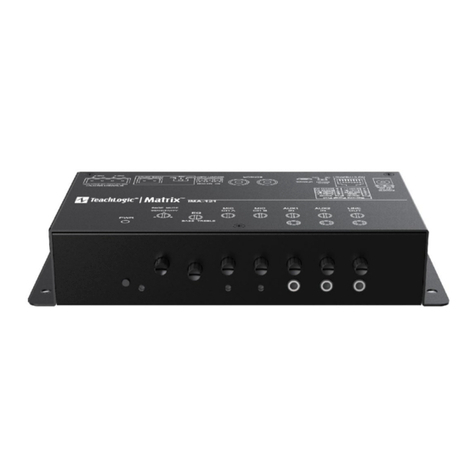
TeachLogic
TeachLogic Matrix IMA-121 User manual
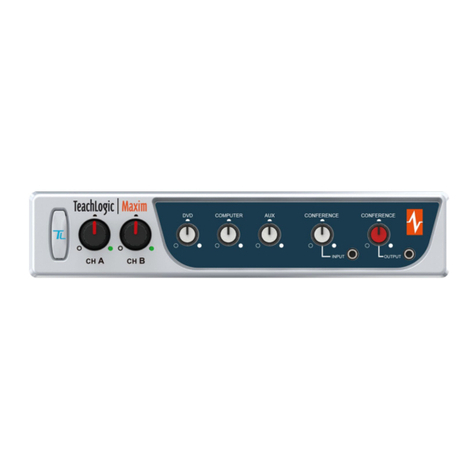
TeachLogic
TeachLogic Maxim IMA-540 User manual
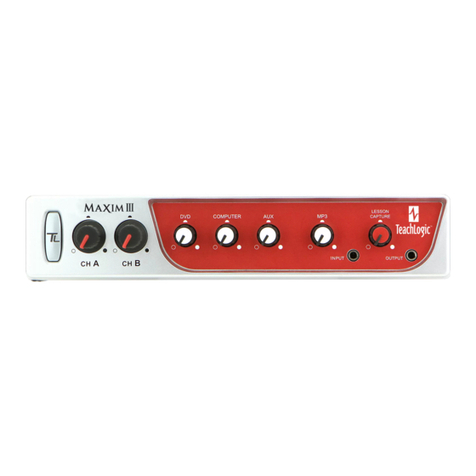
TeachLogic
TeachLogic Maxim III User manual
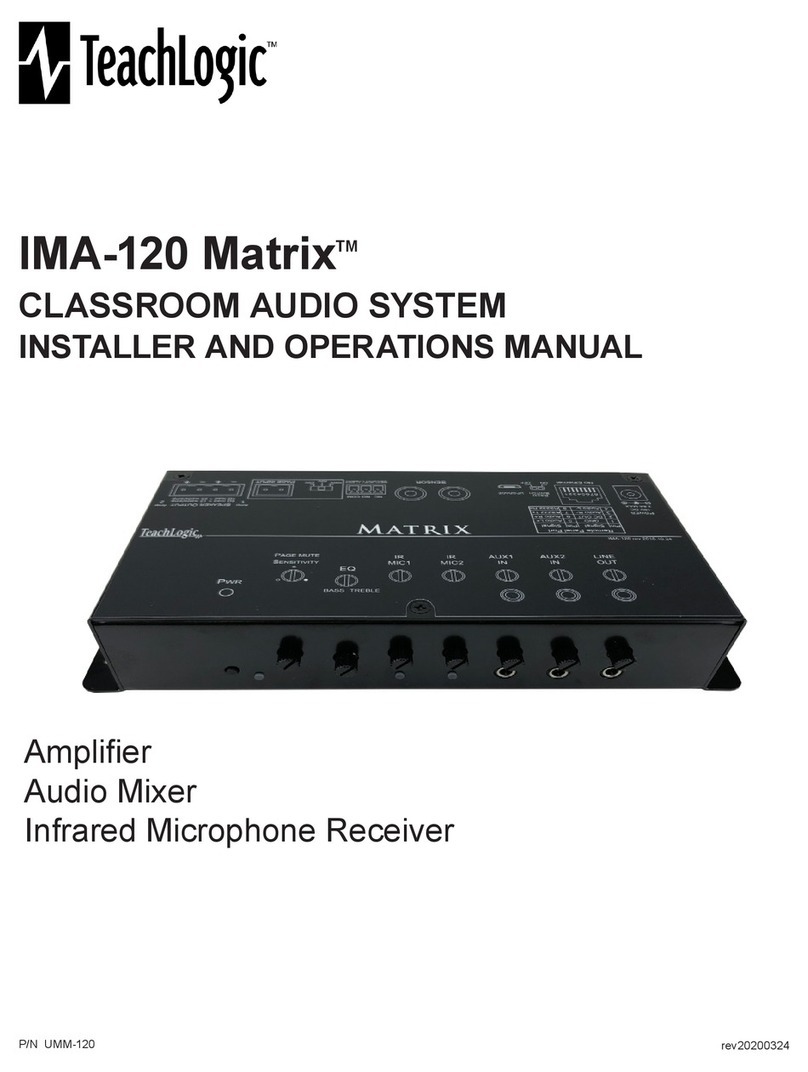
TeachLogic
TeachLogic Matrix User manual
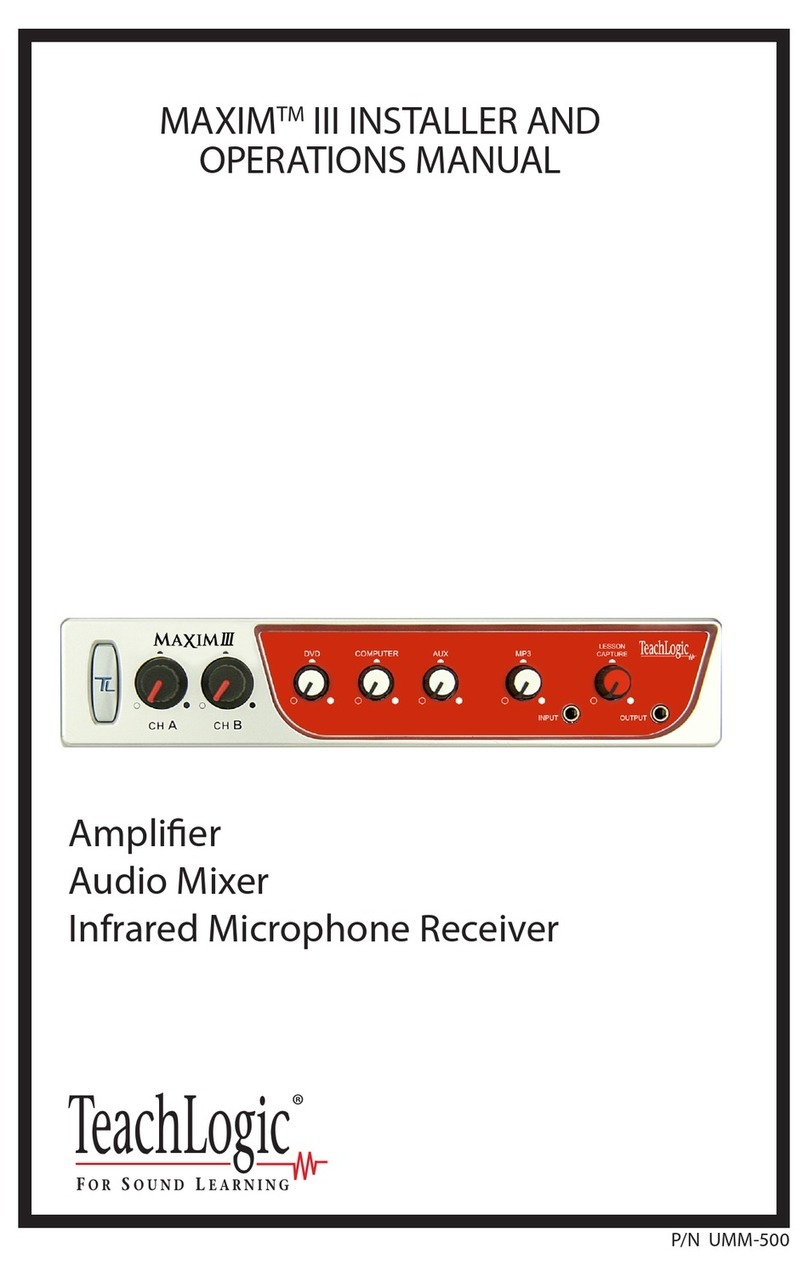
TeachLogic
TeachLogic Maxim III User manual
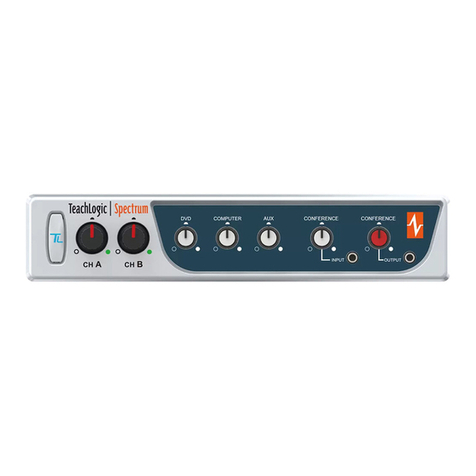
TeachLogic
TeachLogic Spectrum IMA-840 User manual
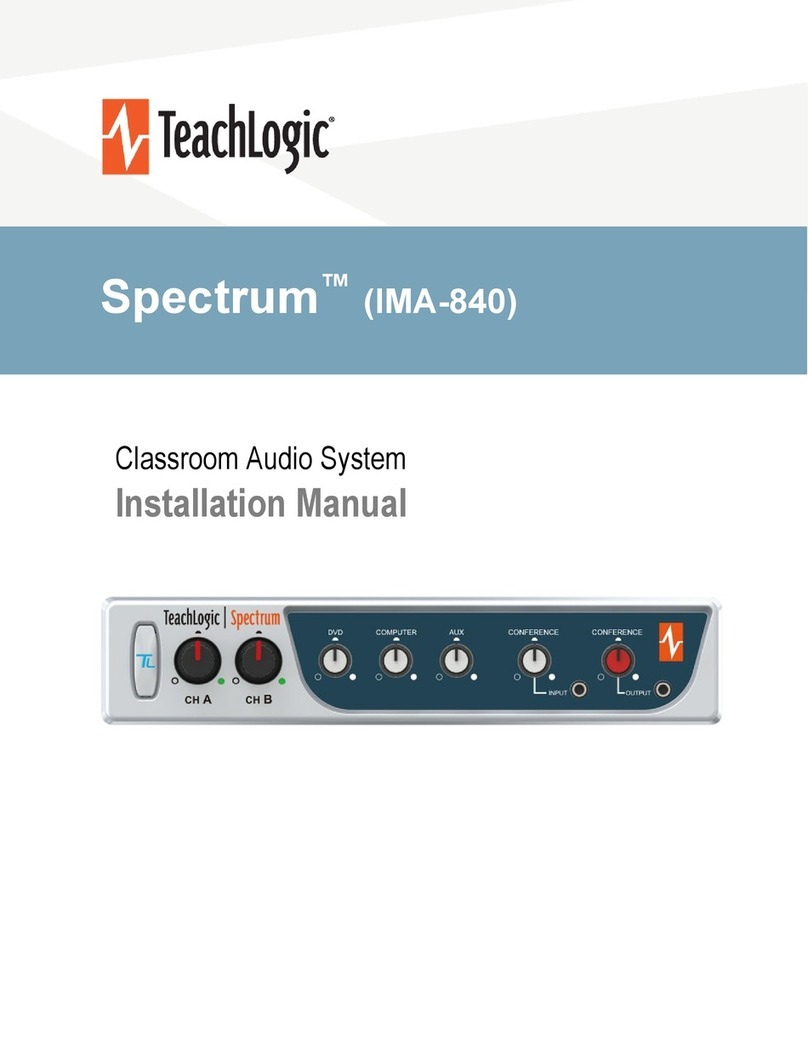
TeachLogic
TeachLogic Spectrum IRS-9650 User manual
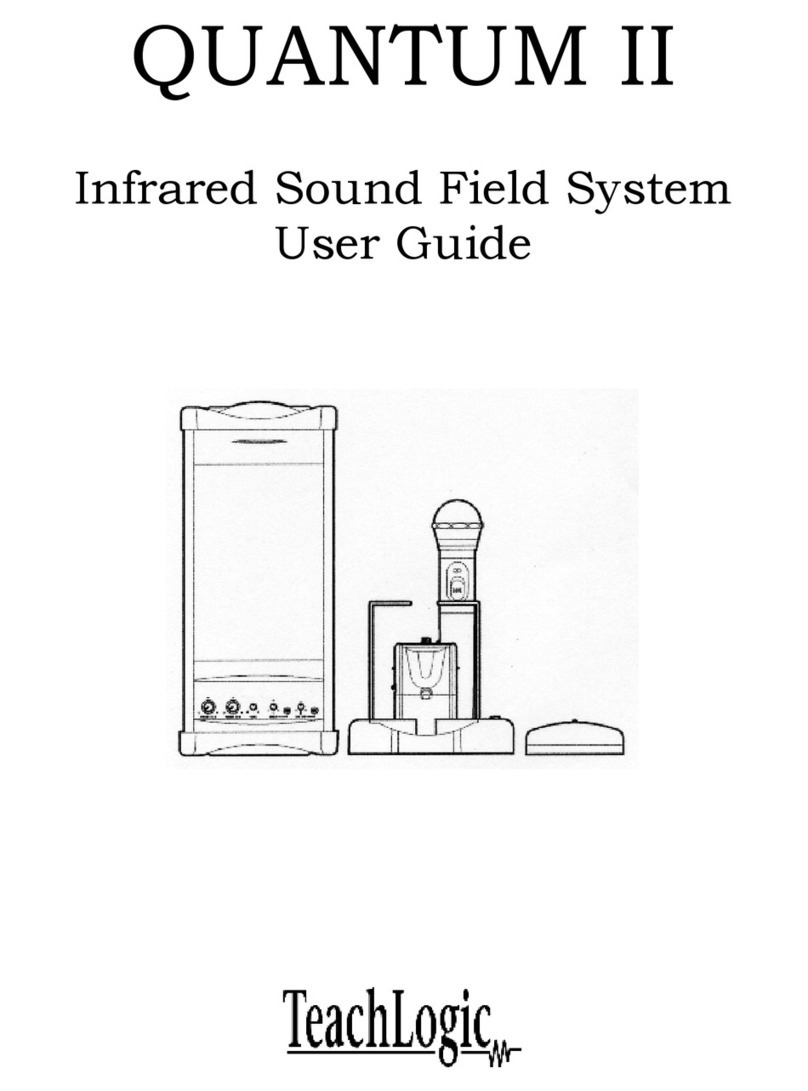
TeachLogic
TeachLogic QUANTUM II User manual
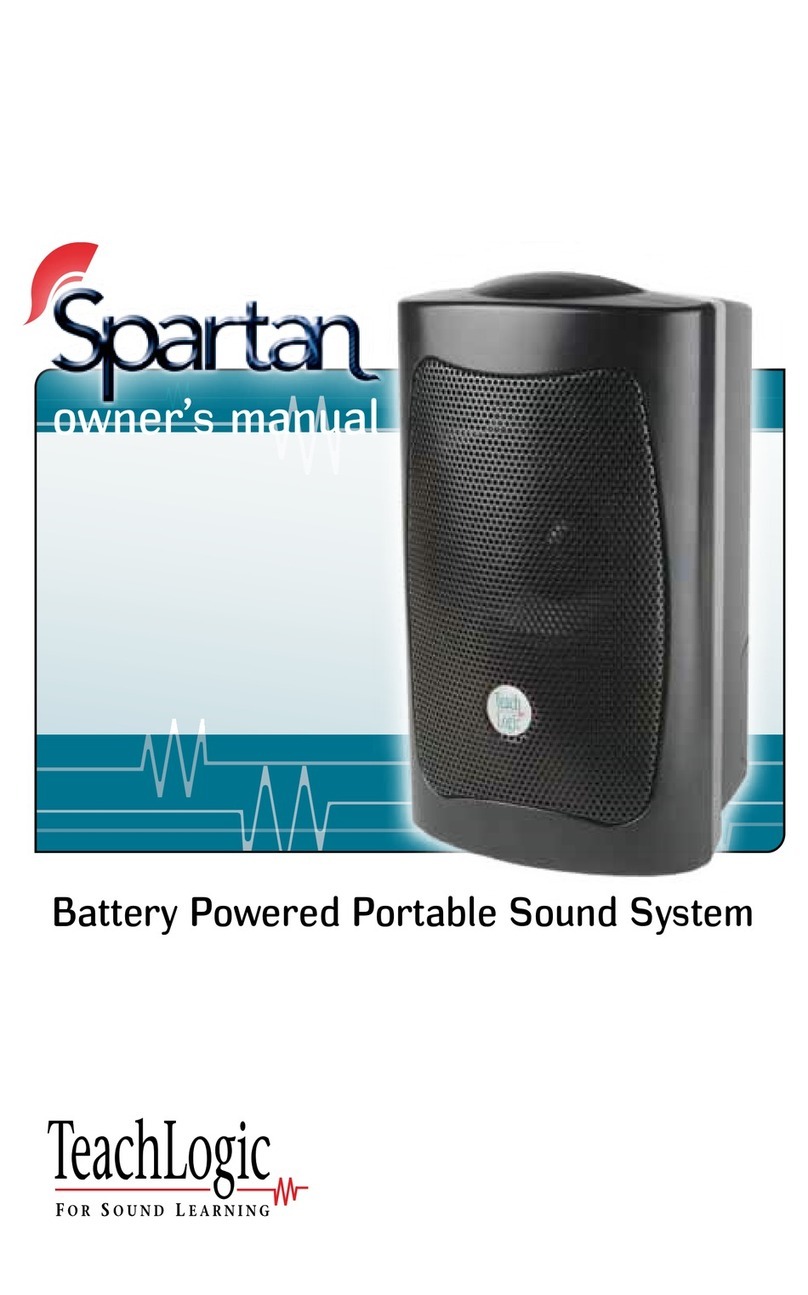
TeachLogic
TeachLogic Spartan User manual

TeachLogic
TeachLogic QUANTUM II User manual
